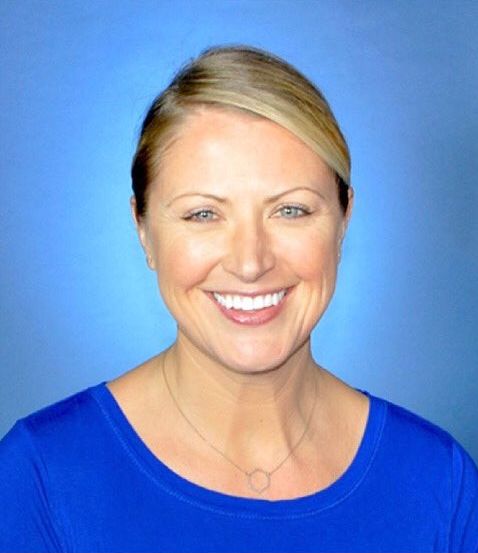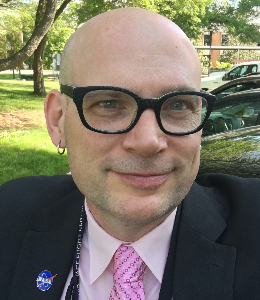GRAA NEWSLETTER
P.O. Box 1184, Greenbelt, MD 20768-1184
UPCOMING LUNCHEONS: We meet at 11:15 AM on the 2nd Tuesday
of each month at the American Legion Post #136 at 6900 Greenbelt Road.
Reservations are required; please contact
graalunch@gmail.com
(preferred) or call (240) 720-7833 before Thursday, August
4th.
| Aug 9 |
 Jody Davis, Deputy Payload Systems Engineer for the Roman telescope
project in Goddard’s Engineering Directorate will present “Roman
Space Telescope: Personal Experiences & Engineering Challenges”.
As a pilot and mountain climber, she has an active life that includes
outreach to students and the public.
Jody Davis, Deputy Payload Systems Engineer for the Roman telescope
project in Goddard’s Engineering Directorate will present “Roman
Space Telescope: Personal Experiences & Engineering Challenges”.
As a pilot and mountain climber, she has an active life that includes
outreach to students and the public.
|
| Sep 13 |
 C. Alex Young, Associate Director for Science in Goddard’s
Heliophysics Science Division, will bring us up to date on Solar missions,
including the Parker Solar Probe as it samples the Solar atmosphere
C. Alex Young, Associate Director for Science in Goddard’s
Heliophysics Science Division, will bring us up to date on Solar missions,
including the Parker Solar Probe as it samples the Solar atmosphere
|
SPECIAL NOTES
This August edition is the first delivery to our non-email members
since March 2020 when Goddard access was restricted during the Covid-19
pandemic, and we could send only electronic copies. We request that
members send their email address to
goddardretirees@gmail.com
for the best quality editions.
We plan to send out our 2022 Member Directory next month. Please submit
any address changes promptly!
Over the past two years, we have lost a number of our members, notably
Alberta Moran, a GRAA founder, and Dave Moulton, our Newsletter
editor. You can see all of our past newsletters, videos of recent talks,
and other GRAA information on our website
goddardretirees.org.
COMMENTS FROM TONY COMBERIATE AND ARLIN KRUEGER
Our July luncheon featured an encore talk titled “Visualizing NASA’
Science Results and Why It Matters,” by Lori Perkins, data software
engineer in NASA’s Scientific Visualization Studio (SVS) in
Goddard’s Sciences and Exploration Directorate. Lori’s prior talk
in September 2021 was plagued with projector problems. Fresh material in this
talk included not only SVS’s dramatic Earth Science, and Solar videos,
but also the first public Webb images released on that day. Lori explained
that these visualizations are designed to be enjoyed by people from
all walks of life and to provide insightful information for the NASA and
worldwide research community. SVS uses the scientists’ data analysis tools
plus Hollywood-class tools used for special effects. Lori’s challenge
is to use the right tool for the job to illustrate the scientific data.
For example, weather satellites obtain data every 5 -30 minutes, whereas
climate scale data are collected daily over months and years. The goal
is to offer the public the information they need to understand transient
local events as well as long-term global changes.
Examples of SVS products include videos of global rainfall and snowfall
changes obtained by the multitude of NASA satellites. Landsat fire data
provide critical information to stakeholders across the country and
around the world. For example, the California Dixie fire was the size
of Rhode Island and, because of the lack of snowpack, was the first to
cross the ridge of the Sierra Nevada Mountains (Lake Tahoe area). Landsat
images show wildfire intensity, burned areas, new fires, and fire lines
to help the recovery effort. Smoke from these fires travels thousands
of miles worldwide. Unfortunately, fires are happening more often with
unabated global warming.
Lori showed Solar Dynamics Observatory images of a solar flare that
resulted in the loss of 40 SpaceX Starlink satellites last February.
Ignoring a geomagnetic storm watch, SpaceX launched the small
communications satellites into initial low orbits designed to cull faulty
units. Atmospheric heating by the flare increased air density and the
satellites were lost before they could be boosted into orbit.
Our luncheon coincided with Goddard’s celebration of Webb’s
successful deployment and activation. Lori showed hi-res images (available at
nasa.gov) of a Deep Field acquired “before breakfast this morning”
(compared with 10 days for the famous Hubble Deep Field image), of
dying binary stars that produced the Southern Ring Nebula, the detection
of water in the spectrum of an exoplanet's atmosphere, of Stephan’s
Quintet, a group of 5 interacting galaxies in the constellation Pegasus
(one containing a supermassive black hole), and a NIRCam image of the
Carina Nebula in our galaxy showing stellar nurseries emerging from dust
clouds. Canadian and European partner countries also highlighted Webb
images this week. These images will deepen our understanding of how the
first stars were made at the birth of the universe.
TREASURER’S REPORT:
Treasurer Jackie Gasch received a tax-deductible donation from Ron
Felice, Jackie Gasch, Barbara Hamilton, Tony Comberiate, Jim Cameron,
Patricia Mackey, William Duffy and Steven Maran.
FROM THE GODDARD ARCHIVES — IT HAPPENED IN AUGUST:
Fifty years ago on August 21, 1972, Atlas-Centaur launched Orbiting
Astronomical Observatory (OAO) Copernicus, which operated 8 years and
provided details of the chemical composition of stars and interstellar
gases.
REMEMBERING OUR FORMER COLLEAGUES:
Earl Benjamin “Ben” Jackson,
79, of Plano, Texas passed away August 3, 2007. He was in the Sounding
Rockets Office in the 1980s and later was the Launch Vehicles Branch
Head in the Wallops Operations Division.
Donald L. Cosner, Sr.,
98, passed away on 8 January 2021 from COVID. He was a pioneer in American
rocketry as one of an elite team of engineers responsible for the Vanguard
and Viking rockets. In 1971, he began working in Spacecraft Stabilization
and Control at Goddard and spent the remainder of his career focused on
near-Earth satellites.
Richard G. Long,
83, of Laurel, MD, passed away September 26, 2021. After serving in the
Navy, Rich began working at Goddard in 1962. He setting up tracking
stations for the Apollo program and later was the Deputy Project
Manager/Resources on the TDRS project and the Hubble Space Telescope
until retiring in 1994.
Jeffrey S. Schweitzer,
76, passed away on May 31, 2022. Jeff was a Visiting Scientist at Goddard
from 1986 until his death. He was commended for helping to establish
an outdoor, remotely operated experimental facility that improved the
ability to show competence of applications for planetary missions.
Thomas D. Taylor Jr.,
86, passed away on Sunday June 5th, 2022. After serving in the Air Force
he helped develop computers to fly on un-manned aircraft and oversaw the
flight software for the OAO and ground software for IUE, UARS, and EOS.
Robert F. “Bob” Amoruso,
87, passed away on June 7, 2022, in Annapolis. Bob was the Goddard
Manpower Utilization Division Chief in the 1970s and spent his career
as a civil servant in several federal government agencies, including
EEO. After retiring, he was an HR director for an accounting firm.
George Lieberman,
85, passed away on June 25, 2022. Following several notable fellowship
awards from NATO, NASA-Goddard, the CEC Corporation and Hughes, George had
a lifelong career in engineering/physics management and research at NIST.
Bill West,
100, passed away on June 30, 2022. He served in the Navy and began his
engineering career at the Naval Aviation Ordnance Test Station (NAOTS)
on Wallops Island. In 1950 he went to work for the National Advisory
Committee for Aeronautics (NACA), and then joined NASA when it was
created in 1958, from which he retired in 1978 as Department Head,
Range Engineering Instrumentation Development (Code 569).
Thomas E. McGunigal,
85, passed away on July 1, 2022. Tom joined Goddard in 1959, and was
the Program Manager for several, groundbreaking satellite programs,
including the Cospas-Sarsat Search and Rescue program, in 1979. He also
worked at NASA HQ, NOAA and Spacecom/Contel.
David “Dave” W. Walser,
83, passed away on Thursday, July 7, 2022, from a long battle with
COVID-19. After serving in the Navy, Dave was an engineer in both
the Cosmic Radiation Branch and the Planetary Systems Branch in the
Laboratory for Extraterrestrial Physics. He retired in 2007 after a 45+
years of service.
Gloria J. Goodman,
77, passed away on July 15, 2022. Gloria was passionate about her career
and proud of her work as Business Manager for Hubble Space Telescope. She
was the beloved wife of the late Lawrence Goodman, also a Goddard retiree.
Nancy Lee Kelly,
84, passed away on Thursday, July 21, 2022. Nancy was the business
administrator at the NASA tracking station on Ascension Island for 7
years. When she returned stateside, she worked at Goddard in Greenbelt.
 Jody Davis, Deputy Payload Systems Engineer for the Roman telescope
project in Goddard’s Engineering Directorate will present “Roman
Space Telescope: Personal Experiences & Engineering Challenges”.
As a pilot and mountain climber, she has an active life that includes
outreach to students and the public.
Jody Davis, Deputy Payload Systems Engineer for the Roman telescope
project in Goddard’s Engineering Directorate will present “Roman
Space Telescope: Personal Experiences & Engineering Challenges”.
As a pilot and mountain climber, she has an active life that includes
outreach to students and the public.
 C. Alex Young, Associate Director for Science in Goddard’s
Heliophysics Science Division, will bring us up to date on Solar missions,
including the Parker Solar Probe as it samples the Solar atmosphere
C. Alex Young, Associate Director for Science in Goddard’s
Heliophysics Science Division, will bring us up to date on Solar missions,
including the Parker Solar Probe as it samples the Solar atmosphere